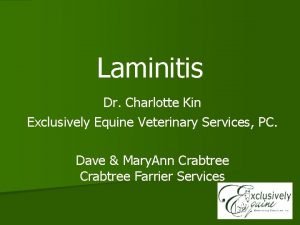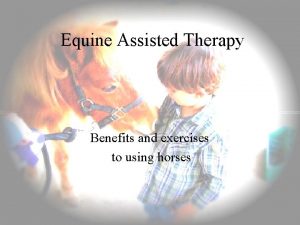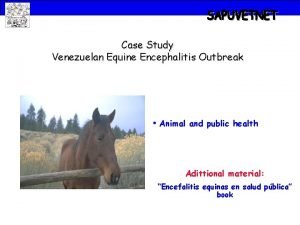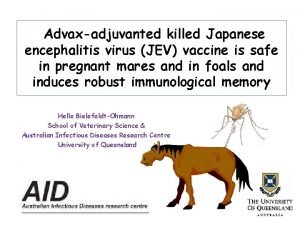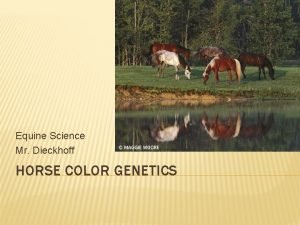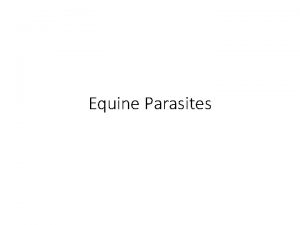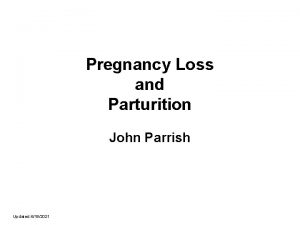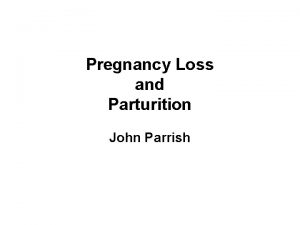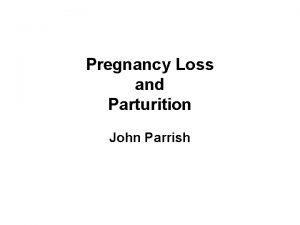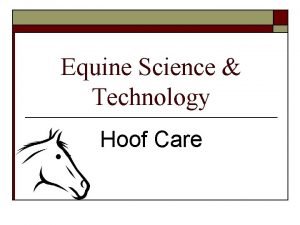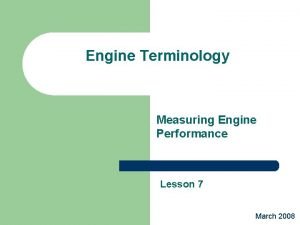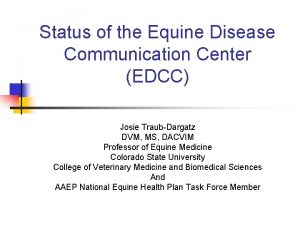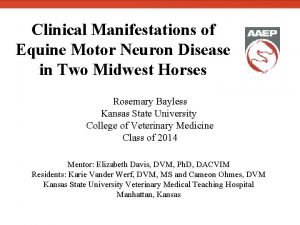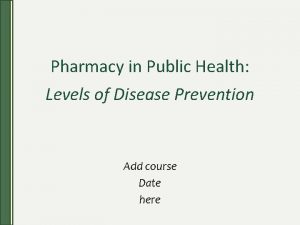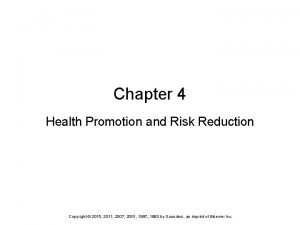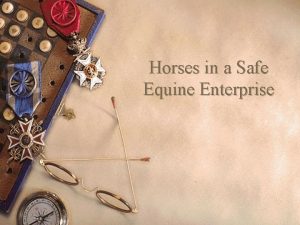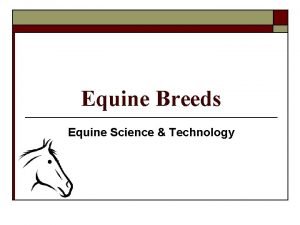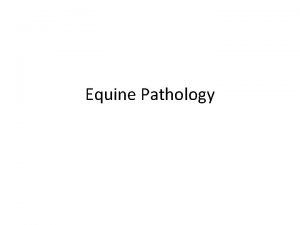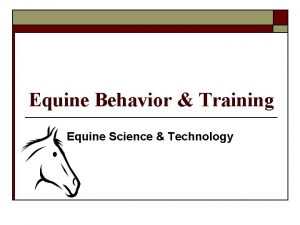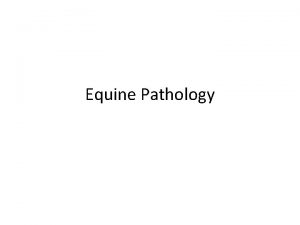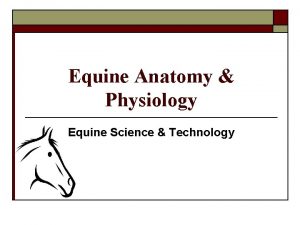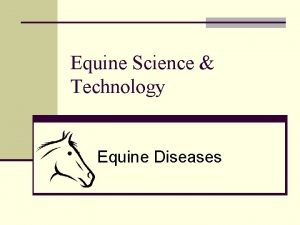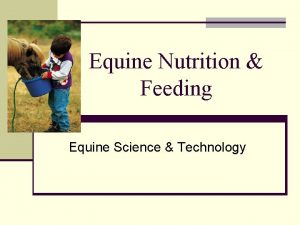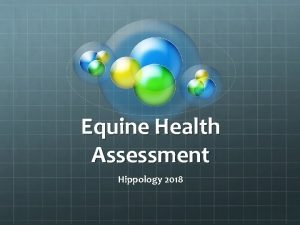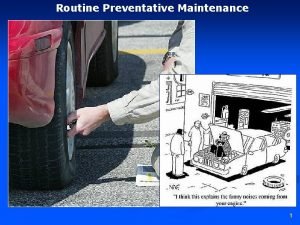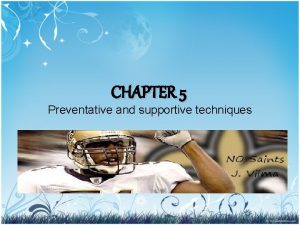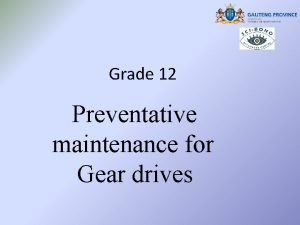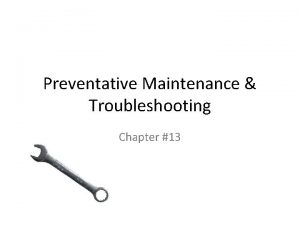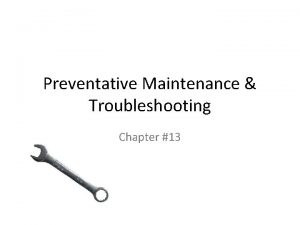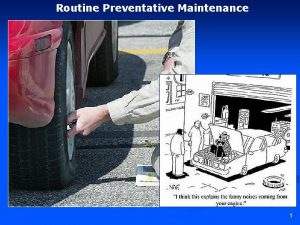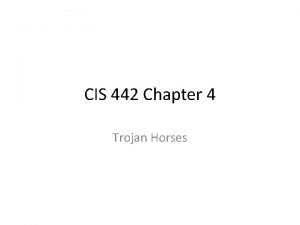Preventative Health Care for Horses Equine 2 Prevention




























- Slides: 28

Preventative Health Care for Horses Equine 2

Prevention ● It is easier and cheaper to PREVENT a disease outbreak than to treat it!!!! ● Prevention starts with cleanliness and sanitation * Keep the barn and pasture area clean -manure should be cleaned daily and pile kept far from the horse area (flies and parasites) * No standing water!!! (Mosquitos)

Prevention ● remove debris ● keep fences, gates, etc in good condition, check for nail pops, broken boards, etc ● Keep water and feed buckets clean

How are diseases spread? Vector- anything that spreads diseases Non-living Vectors ● Buckets, tools, clothing, boots, health equipment (needles) Living Vectors ● Insects (mosquitos, flies), Parasites, other livestock (certain diseases), humans,

Spreading Diseases Disease can be spread through: ● Air (fine mist like particles) ● Touch/contact with body fluids (saliva, mucus, vaginal secretions, semen) ● Contaminated equipment

What causes diseases? Pathogens- microbes that cause disease ● Bacteria ● Virus ● Fungus ● Prions ● Protozoa

Keeping Horses Healthy

Antigens Pathogens that invade the body and cause a reaction to occur ● (body reacts to defend itself from invasion) ● virus, bacteria, toxin, etc

How do horses fight antigens? Several lines of defense ● First Line of Defense ○ ○ ○ skin, hair, hooves (physical barriers) mucus membranes (tears, earwax, urine) Nostrils (hair, mucus) Digestive System (acids) Blood

Second line of Defence- Immune System ● White Blood Cells ○ ○ produced in bone marrow Circulate through the body to get rid of dead, worn out cells (Think of these as the Army Privates- they do the grunt work) ■ Phagocytes● ○ specialized WBC that produce chemicals to produce more WBC (supply soldiers) *elevated WBC counts indicate disease

Immune System Lymphocytes● Produced in the lymph nodes react to foreign substances by releasing chemicals that kill or inactivate the pathogen (Army Rangersspecialized soldiers) ● Antibodies- the chemical released by lymphocytes ○ the body creates antibodies specific to each and every antigen that enters the body and remembers them for future use

Antibodies To successfully fight off the antigen than the body must produce enough antibodies ● It is when the body can’t fight them off or can’t do it quickly enough that symptoms of infection show

Future Exposure When an animal is exposed to the antigen again in the future the body remembers and has the antibodies ready to fight it ● often the response is quicker the 2 nd time around and last longer ● (you don’t have a reaction/don’t get sick)

Immunity • an animal is protected from catching a certain disease ● Animal’s body is capable of producing enough antibodies fast enough to neutralize the disease

Types of Immunity ● When a baby is born it has essentially no immune system ○ It must be built immediately to prevent serious, life -threatening illness ● Mothers pass on some immunity to their offspring through the placenta during pregnancy

Types of Immunity ● During the first 24 hours of life an animal's digestive system is open, meaning that antibodies found in the colostrum “first milk” are absorbed directly into the bloodstream providing immediate immunity This type of immunity is called PASSIVE IMMUNITY ● TEMPORARY immunity, the foals body must create its own antibodies


Active Immunity The second type of immunity is called ACTIVE IMMUNITY- - the animal actually contracts the disease and recovers - body creates its own antibodies - The contraction may be natural or artificial (vaccinations)


Why should we vaccinate? • Critical component of a horse health maintenance program • Primes the immune system for a quick response when exposed to infection • Prevent life-threatening diseases • Minimize or eliminate contagious diseases that affect performance or herd health

Vaccination can NOT guarantee disease prevention in all cases • Vaccination should be used in conjunction with good nutrition, deworming, pasture management, and minimizing stress in your herd

Types of Vaccinations 1. Modified Live Vaccine the antigen is alive, but the virulence (severity) has been significantly reduced through laboratory procedures (heat, cold, etc) ii. allows the body to produce a higher number of antibodies quickly i. 1. usually animal may show symptoms of being sick as the immune system is creating the antibodies, but the animal doesn’t actually contract the disease

Types of Vaccinations 2. Recombinant Vaccine ● in a laboratory setting the antigen is broken apart and only the part that causes the disease is put into the vaccine. ● he recombinant vaccine, then, does not contain T the whole virus or bacteria, but just those parts which produce the best antibody response in the animal to be vaccinated.

Types of Vaccinations 3. Killed Vaccine ● the antigen is killed and put into a liquid base for the vaccine they cannot reproduce inside the body so the antibody production is limited to the number of antigen cells in the vaccine. ○ Other ingredients are used to help boost the immune response, however, these also tend to cause allergic reactions ○

How are vaccines given? 1. Most are given Intramuscular (IM) 2. Some are given Intranasal (IN)

Possible reactions to Vaccines • Anaphylactoid reactions: allergic reactions • Fever • Lameness • Swelling or abscess formation at the injection site

What Should I Vaccinate For? ALL HORSES • Tetanus • Encephalomyelitis • West Nile Virus • Rabies • MOST/PERFORMANCE • Influenza • Equine Herpesvirus • SOME • Strangles • Potomac Horse Fever • Botulism • Rotavirus

 Primary prevention secondary prevention tertiary prevention
Primary prevention secondary prevention tertiary prevention Politeness theory in communication
Politeness theory in communication Prolight 1000 cnc mill
Prolight 1000 cnc mill Preventive system of don bosco
Preventive system of don bosco Health care levels primary secondary tertiary
Health care levels primary secondary tertiary Care value base health and social care
Care value base health and social care Exclusively equine vet
Exclusively equine vet Lingfield vets
Lingfield vets Equine definition
Equine definition Us pony club stall card
Us pony club stall card Equine encephalitis
Equine encephalitis Equine encephalitis
Equine encephalitis Pasture pals equine rescue
Pasture pals equine rescue Rhinopneumonitis definition
Rhinopneumonitis definition Equine color calculator
Equine color calculator Equine
Equine Parturition
Parturition Equine
Equine Equine
Equine Equine science
Equine science Equine science
Equine science Equine-based unit of engine performance
Equine-based unit of engine performance Equine disease communication center
Equine disease communication center Rto incompass
Rto incompass Equine motor neuron disease
Equine motor neuron disease Health and social component 3
Health and social component 3 Workwell prevention & care
Workwell prevention & care Health promotion and levels of disease prevention
Health promotion and levels of disease prevention Health promotion and levels of disease prevention
Health promotion and levels of disease prevention






